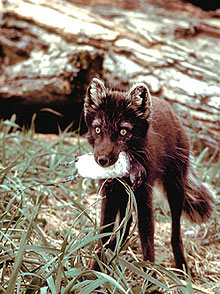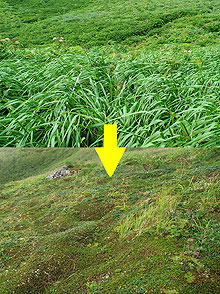March 28, 2005
Study shows introduced foxes transformed
vegetation on Aleutian Islands from lush grassland to tundra
By Tim Stephens
Huge colonies of seabirds accustomed to nesting on islands
free of predators began disappearing when fur traders started
introducing foxes onto islands in the Aleutian archipelago in
the 18th century.

Introduced arctic fox taking a least auklet, a seabird breeding
in the Aleutian Islands, Alaska Maritime National Wildlife
Refuge. Fox predation decimated seabird populations and
reduced the guano supplied by seabirds to the Aleutians,
transforming the vegetation on the islands from productive
plant communities dominated by grasses to less productive
communities dominated by low-lying shrubs.
Photo: A.
DeGange |

Grass-dominated plant communities in the Aleutian Islands
(top) have been transformed to communities dominated by
low-lying shrubs (bottom) due to reduced nutrient inputs.
Foxes introduced for the Alaska fur trade decimated breeding
seabird populations on the islands, leading to reduced nutrient
input from seabird guano.
Photo: D. Croll et al. |
The ground-nesting birds made easy meals for the foxes. A study
published this week in the journal Science now shows
that the effects of the introduced foxes rippled through entire
island ecosystems, transforming the vegetation from lush grasslands
to scrubby, low-growing tundra.
It turns out that the nutrient-poor volcanic soils of the Aleutian
archipelago can only support dense grasslands if they receive
regular doses of fertilizer in the form of bird droppings.
On islands without foxes, seabirds transfer nutrients from
the ocean to the land by feeding on marine fish and invertebrates
and spreading nutrient-rich guano around the islands. Add foxes,
and the indirect effects on the whole ecosystem are as dramatic
as the direct effects on the seabirds.
"Introduced species are a global phenomenon, and we tend
to focus on the direct effects, such as the reduction or extinction
of species that are consumed by an introduced predator. This
study shows how the effects of introduced species can spread
throughout an ecosystem in unpredictable ways," said Donald
Croll, an assistant professor of ecology and evolutionary biology
at UCSC and first author of the Science paper.
Efforts by the U.S. Fish and Wildlife Service to remove introduced
foxes from the Aleutian islands have been largely successful.
Seabirds are beginning to make a comeback on islands previously
colonized by foxes, and in some places the vegetation has begun
to look lusher.
But it is likely to take decades for the ecosystems to fully
recover from the effects of the foxes, said James Estes, adjunct
professor of ecology and evolutionary biology at UCSC and a
coauthor of the paper.
"Most seabirds only have a single offspring each year,
so their capacity for population increase is quite low. The
foxes are mostly off the islands now, but we will probably continue
to see the effects for a long time," Estes said.
In addition to Croll and Estes, the authors of the Science
paper include UCSC graduate student Eric Danner, University
of Montana plant ecologist John Maron, and USFWS biologist Vernon
Byrd. The study grew out of conversations between Estes, who
has been doing research in Alaskan coastal waters for decades,
and Byrd, the supervisory biologist for the Alaska Maritime
National Wildlife Refuge. While working to save the endangered
Aleutian Canada goose, which the foxes were driving toward extinction,
Byrd had noticed the differences between islands with and without
foxes and speculated that nutrients might play a role.
"He had these interesting ideas about foxes and birds
and nutrient chains, and I thought we should do some studies
to see how robust the idea is," Estes said.
The team of researchers, accompanied by a small army of student
assistants, conducted extensive surveys on the islands for several
weeks each summer over three years. They surveyed dozens of
islands from one end of the archipelago to the other. Estes
said the differences were striking between fox-free islands
and fox-infested islands (defined as those where self-sustaining
populations of foxes persisted into the late 1990s).
"When you go to an island that had foxes, it's very easy
to walk around because the plants don't grow much higher than
your ankles. But on the other islands, it's hard work just to
get through the vegetation. It was exhausting just trying to
get around on those islands," he said.
The researchers found that the density of breeding seabirds
on fox-free islands was two orders of magnitude higher than
on fox-infested islands. The resulting difference in nutrient
inputs was reflected in soil phosphorus levels that were more
than three times higher on fox-free islands. The vegetation
on the islands also showed significant differences in nutrient
content.
Evidence that more ocean-derived nutrients were cycling through
the ecosystems of fox-free islands than on fox-infested islands
came from analyses of nitrogen isotopes in soil, plant, and
animal samples.
"The terrestrial ecosystem was being subsidized by marine-derived
nutrients, and the foxes basically cut off the subsidies by
interrupting the flow of nutrients coming from offshore,"
Croll said. "It transformed the plant community from one
that does well in nutrient-rich conditions to one that does
well in nutrient-depleted conditions."
Foxes were first introduced to some of the islands by Russian
fur traders in the mid- to late-18th century as a way to supplement
the declining harvest of sea otter pelts. But the practice escalated
between the 1890s and the 1930s, when the U.S. government worked
to establish fox farming businesses on the islands. Mostly arctic
foxes and smaller numbers of red foxes were introduced to more
than 400 islands.
Byrd, who has been involved in restoration efforts in the Aleutian
islands since 1971, said most of the islands had major breeding
colonies of seabirds before the arrival of foxes. There are
about 26 species of seabirds that regularly nest on the islands,
he said. They include surface nesters, such as gulls and terns,
that lay their eggs on the ground; burrow nesters, such as puffins,
that dig burrows in the soil for their nests; and crevice nesters,
such as auklets, that nest in boulder piles and rock crevices.
According to Byrd, surface nesters and burrow nesters tended
to disappear completely from islands with foxes, while populations
of crevice nesters were reduced but not eliminated. Ledge nesters
such as murres and kittiwakes, which nest on steep cliff faces,
were less affected by the foxes, he said.
"Wherever the puffins and gulls have come back after the
removal of the foxes, the vegetation has started to become lusher
again," Byrd said. "The terrestrial ecosystem was
probably modified in more ways than we know, and maybe it won't
be exactly like it was, but the conditions are there for a successful
restoration of the native biodiversity."
Return to Front Page